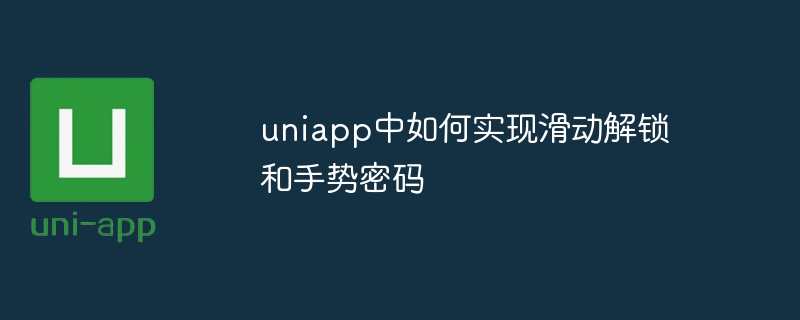所属分类:web前端开发

实现滑动解锁和手势密码是UniApp中常见的需求,本篇文章将为大家详细介绍如何在UniApp中实现这两个功能,并提供具体的代码示例。
一、滑动解锁
滑动解锁是一种常见的手机解锁方式,在UniApp中实现滑动解锁可以通过监听touch事件来实现。
具体步骤如下:
<view class="slider" @touchstart="touchStart" @touchmove="touchMove" @touchend="touchEnd"></view>
data() {
return {
startX: 0, // 滑块开始滑动的初始位置
moveX: 0, // 滑块滑动的距离
unlocked: false // 是否解锁成功的标志
}
}methods: {
touchStart(event) {
this.startX = event.touches[0].clientX
},
touchMove(event) {
this.moveX = event.touches[0].clientX - this.startX
// 根据滑块的滑动距离判断是否解锁成功
if (this.moveX >= 80) {
this.unlocked = true
}
},
touchEnd() {
// 根据解锁成功标志判断是否跳转到解锁成功页面
if (this.unlocked) {
uni.navigateTo({
url: '/pages/unlocked/unlocked'
})
}
}
}.slider {
width: 300rpx;
height: 100rpx;
background-color: #ccc;
border-radius: 50rpx;
}通过以上步骤,我们就可以在UniApp中实现滑动解锁的功能了。用户滑动滑块距离大于80个px时,会跳转到解锁成功的页面。
二、手势密码
手势密码是一种常见的手机解锁方式,在UniApp中实现手势密码可以通过canvas绘制和事件监听来实现。
具体步骤如下:
<canvas id="canvas" @touchstart="touchStart" @touchmove="touchMove" @touchend="touchEnd"></canvas>
data() {
return {
ctx: null, // canvas上下文
startX: 0, // 手指触摸的初始位置
startY: 0,
points: [], // 绘制路径所需的所有点
password: '' // 用户设置的手势密码
}
}onLoad() {
// 获取canvas上下文
this.ctx = uni.createCanvasContext('canvas', this)
}methods: {
touchStart(event) {
this.startX = event.touches[0].clientX
this.startY = event.touches[0].clientY
// 清除之前的绘制路径
this.points = []
},
touchMove(event) {
let moveX = event.touches[0].clientX - this.startX
let moveY = event.touches[0].clientY - this.startY
// 更新绘制路径的点
this.points.push({x: moveX, y: moveY})
this.ctx.clearRect(0, 0, 300, 300) // 清除canvas
this.drawGesture() // 绘制手势路径
},
touchEnd() {
// 将绘制路径转换成密码
this.password = this.pointsToString(this.points)
console.log('设置的手势密码为:' + this.password)
},
drawGesture() {
this.ctx.beginPath()
this.points.forEach((point, index) => {
if (index === 0) {
this.ctx.moveTo(point.x, point.y)
} else {
this.ctx.lineTo(point.x, point.y)
}
})
this.ctx.stroke()
this.ctx.closePath()
this.ctx.draw()
},
pointsToString(points) {
return points.map(point => {
return Math.floor((point.x + 150) / 100) + Math.floor((point.y + 150) / 100) * 3 + 1
}).join('')
}
}canvas {
width: 300rpx;
height: 300rpx;
background-color: #eee;
}通过以上步骤,我们就可以在UniApp中实现手势密码的功能了。用户按照自己的需求在canvas中划线,划线的路径将通过转换成相应的数字密码,并打印在控制台中。
总结:
本文介绍了在UniApp中如何实现滑动解锁和手势密码功能,并提供了相应的代码示例。通过以上实现方法,我们可以轻松地在UniApp中实现滑动解锁和手势密码功能,为用户提供更加便捷和安全的手机解锁方式。希望本文对大家有所帮助!